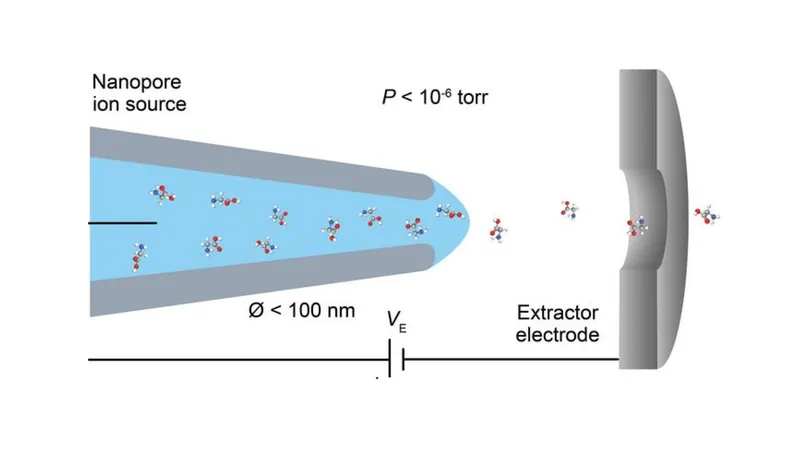
Revolutionary Tricorder Technology: New Mass Spectrometry Breakthrough Could Change How We Analyze Samples Forever!
2024-11-21
Author: Wei Ling
Introduction
In the world of scientific research, mass spectrometry reigns supreme as a method for breaking down and identifying the intricate components of a vast array of substances by measuring their particle masses. However, this powerful technique is often underutilized due to a staggering 99% sample loss that occurs before analysis even begins. This high rate of loss diminishes the reliability and sensitivity of the results, leading to wasted resources and increasing the likelihood of errors during sample preparation.
Breakthrough Development
But a groundbreaking development from a research team at Brown University might put an end to these limitations. They've pioneered an innovative method that significantly minimizes sample loss, ensuring that nearly all of the material remains for analysis.
The New Ion Source
Nicholas Drachman, a physics Ph.D. student at Brown and the lead researcher, explained how the conventional technique typically used for producing ions, known as electrospray ionization, is inefficient. This method utilizes a sharp needle that generates a spray of charged droplets to create ions, but only a minuscule fraction makes it into the actual mass spectrometer. "We’re essentially scattering the sample everywhere to produce ions," Drachman remarked. Their new approach, known as a "nanopore ion source," bypasses this chaos entirely.
The Nano Structure
This innovative technology features a tiny capillary opening just 30 nanometers wide—around 1,000 times narrower than a human hair. To put this into perspective, the standard needle used in electrospray ionization has an opening approximately 20 micrometers wide, which is a staggering 600 times larger.
Eliminating Messy Processes
The nanopore ion source has the remarkable capability to transfer ions, even those dissolved in water, directly into a vacuum, eliminating the need for the messy drying process typically required in traditional methods. Additionally, since the new mechanism does not draw in large amounts of gas, the complexity of vacuum systems in mass spectrometers is greatly reduced. “We essentially eliminate the need for the cumbersome multi-stage vacuum pumps that are typically needed,” Drachman added.
Commercial Applications
Inspired by recent advances in nanopore sequencing technologies, the Brown team envisions this innovation being applied commercially, especially in the field of proteomics—the study of proteins. This breakthrough comes at a crucial time, as advancements in protein research have lagged behind those seen in genomics over the past two decades.
Significance in Protein Analysis
“Mass spectrometry is paramount for protein analysis since it can distinguish between the numerous amino acids due to their varying masses,” noted Derek Stein, a professor of physics at Brown and one of the paper's authors. “By resolving the sample loss issue, we unlock the ability to perform much more sensitive analyses, such as sequencing proteins one amino acid at a time, which has long been a dream in the field.”
Long Journey to Development
The Brown team dedicated a decade to developing this method, starting with a custom-designed mass spectrometer capable of integrating their innovative ion source. They crafted tiny openings in glass tubes through a meticulous process of heating and pulling, leading to frequent challenges and setbacks. “Some days things worked flawlessly, while others were nothing short of chaotic,” Stein reflected on the ups and downs of the research journey.
Future Goals
Now, the team has successfully demonstrated that their new ion transfer method can achieve detection results comparable to conventional techniques, but with far less material loss. This means a much more efficient and accurate way to analyze minuscule samples is finally on the horizon.
Broader Implications
With the proof of concept established, the scientists are eager to further refine their technology to enhance proteomic workflows, pushing the boundaries of what is currently achievable in protein science. “Our next goal is to demonstrate that this breakthrough can substantially improve laboratory analyses and assist researchers across various fields,” said Drachman.
Conclusion
The implications of this innovative technology could be profound, enabling never-before-seen advancements in biomedical research, drug development, and beyond. The quest for deeper insights into life’s fundamental processes may soon be empowered by a tool reminiscent of science fiction, capable of analyzing samples with unprecedented efficiency and precision. Stay tuned as this project unfolds; the ability to revolutionize our understanding of proteins may be just around the corner!




 Brasil (PT)
Brasil (PT)
 Canada (EN)
Canada (EN)
 Chile (ES)
Chile (ES)
 España (ES)
España (ES)
 France (FR)
France (FR)
 Hong Kong (EN)
Hong Kong (EN)
 Italia (IT)
Italia (IT)
 日本 (JA)
日本 (JA)
 Magyarország (HU)
Magyarország (HU)
 Norge (NO)
Norge (NO)
 Polska (PL)
Polska (PL)
 Schweiz (DE)
Schweiz (DE)
 Singapore (EN)
Singapore (EN)
 Sverige (SV)
Sverige (SV)
 Suomi (FI)
Suomi (FI)
 Türkiye (TR)
Türkiye (TR)